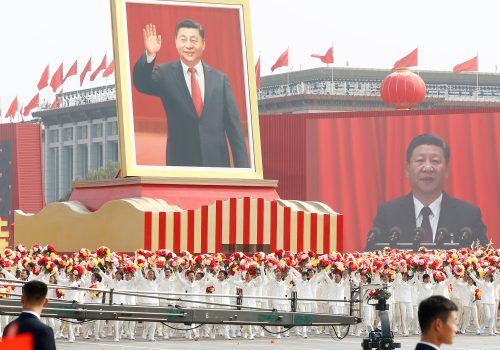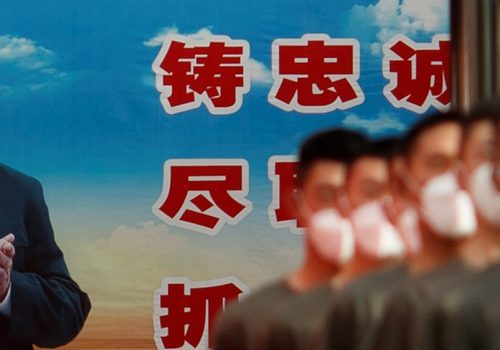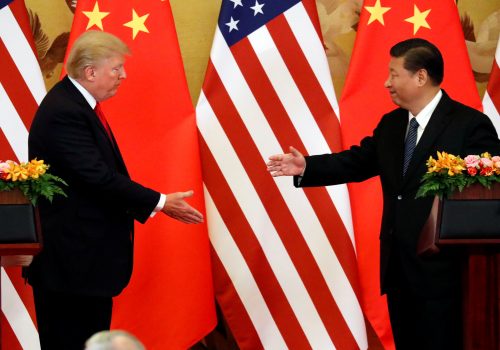The China plan: A transatlantic blueprint for strategic competition
Lead Authors: Hans Binnendijk and Sarah Kirchberger
Project Director: Connor McPartland
Study and Editorial Director: Christopher Skaluba
Contributing Authors: James Danoy, Franklin D. Kramer, Clementine G. Starling, Didi Kirsten Tatlow
Executive summary and principal recommendations
China presents the United States and its partners with the most serious set of challenges they have faced since the Cold War. The scope of those challenges is global. Their potential impact is deep. Left unaddressed, they will harm the fundamental vital interests of democratic nations everywhere. Collective action between the United States and its European partners, coordinated with like-minded nations in Asia, is needed to deflect these challenges, protect our vital interests, and seek a change in China’s policies. Several strategies have been offered to manage China. What is missing is a blueprint—a “China Plan”—to guide the United States and its partners in this endeavor. This study represents such a blueprint.
Conducted over the course of a year and drawing on the research and opinions of hundreds of experts, policy makers, and academics in the United States, Europe, and Asia, this study delves into three broad trends and analyzes five major areas in which Chinese actions threaten transatlantic interests: human rights, coercive diplomacy, predatory economic practices, technology competition, and security challenges.
In doing so, this study identifies areas of convergence, divergence, and asymmetry in transatlantic attitudes towards China, arguing forcibly that a transatlantic response is urgent and necessary to prevent China from remaking the rules-based order to its singular advantage. It concludes with ten recommended steps for minimizing divergences as a means to building a coordinated transatlantic blueprint for confronting, competing with, and, where possible, cooperating with China.
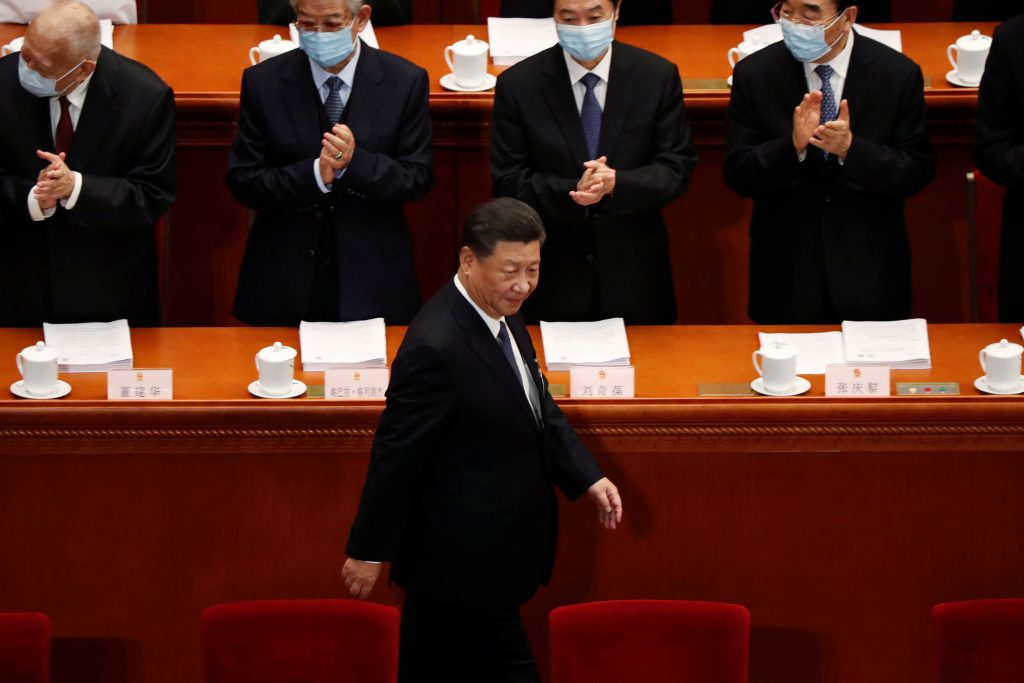
…a transatlantic response is urgent and necessary to prevent China from remaking the rules-based order to its singular advantage.
Chinese President Xi Jinping walks past officials wearing face masks following the coronavirus disease (COVID-19) outbreak as he arrives for the opening session of the National People’s Congress (NPC) at the Great Hall of the People in Beijing, China May 22, 2020. REUTERS/Carlos Garcia Rawlins
Three defining trends
Three major developing trends together provide both an opportunity and a requirement for transatlantic nations to make a concerted effort to promote and protect their interests in the face of a broad spectrum of assertive Chinese policies. China’s increased assertiveness in its international relations combined with bipartisan consensus about the threat China poses in the United States and growing discontent with harmful Chinese behavior in Europe create an environment ripe for closer collaboration among transatlantic nations. These three trends are discussed in Chapter I.
1. Xi’s China has become more authoritarian, outward-facing, and assertive in promoting China’s interests.
Under Chinese President Xi Jinping, the Chinese Communist Party (CCP) has taken a more dominant position in governance in China, the economy has become more state-driven, and Western liberal values have been explicitly disavowed. Externally, Deng Xiaoping’s traditional admonition to “bide one’s time and hide one’s light,” lest the outside world gang up on a rising China, has been given up in favor of a more assertive, at times aggressively coercive, outward approach. China’s economic strengths give it a strong platform on which to base its international actions. But beyond economics and trade, the CCP’s domestic insecurities are now projected outward, be it in the form of bolstering the leadership of autocratic nations by exporting surveillance and control technologies, infiltrating the leadership structures of international organizations with party-state representatives, attempting to control public discourse within democratic countries where it relates to Chinese interests, or aligning China closer with Russia, Iran, and other powerful nondemocratic countries. Heightened military threats to Taiwan, India, Japan, Vietnam, and to virtually all the rival claimants in China’s maritime territorial disputes are yet another aspect of this shift in policy. As a result, the risk of open conflict in Asia involving China has increased during this past year.
2. Bipartisan consensus in the United States provides a strong foundation for policy.
In the United States, there is now bipartisan agreement that the best way to deal with China is to confront it in a unified manner with global partners. A recent Pew Research Center poll found that 73 percent of Americans expressed an unfavorable view of China. 1Laura Silver, Kat Devlin, and Christine Huang, Americans Fault China for Its Role in the Spread of COVID-19, Pew Research Center, July 30, 2020, https://www.pewresearch.org/global/2020/07/30/americans-fault-china-for-its-role-in-the-spread-of-covid-19/. The Trump administration pursued erratic unilateral efforts with respect to challenging China until late in its tenure, leaving many European partners alienated and unwilling to pursue united actions in concert with Washington. US President Joseph R. Biden, Jr., has indicated he will challenge China similarly to the Trump administration, but with a different style and emphasis. Biden has said he will focus on international rules of the road and be extremely competitive, but seek to avoid conflict. Members of his new administration have already criticized China’s economic and human rights policies, and a representative of Taiwan was invited to Biden’s inauguration. In his first phone call with Xi on February 10, Biden criticized China for its coercive and unfair economic practices, human rights abuses, and increasingly assertive actions in Asia. Biden has continued vigorous Freedom of Navigation Operations in the South China Sea and US Naval transits of the Taiwan Strait. At the same time, he has mentioned pursuing practical, results-oriented engagements with China when it is in US and allied interests. Coordinating policies with allies and partners is a centerpiece of Biden’s foreign policy agenda.
3. European leaders have grown more skeptical of China, paving the way for strengthened transatlantic cooperation.
Many European leaders have recently done an about face and become more concerned about Chinese policies, issuing unprecedented critical remarks including a call for greater unity among democratic nations to manage a rising China. European Union (EU) High Representative Josep Borrell believes that “the West was naïve with regard to China,” while NATO Secretary General Jens Stoltenberg has stated: “In a world of greater global competition, where we see China coming closer to us from the Arctic to cyber space, NATO needs a more global approach.”2Josep Borrell, “China, the United States and us,” European External Action Service, July 31, 2020, https://eeas.europa.eu/headquarters/headquarters-homepage/83644/china-united-states-and-us_en; NATO, “Remarks by NATO Secretary General Jens Stoltenberg on launching #NATO2030 – Strengthening the Alliance in an increasingly competitive world,” June 8, 2020, https://www.nato.int/cps/en/natohq/opinions_176197.htm. Numerous national and EU leaders have voiced similar concerns. France and the United Kingdom in particular have indicated their strong opposition to China’s human rights abuses and attempts to restrict the freedom of navigation. Germany has been less forceful, but it has consistently offered safe harbor to Chinese dissidents. Sweden has gone farthest in its efforts to curb authoritarian influences by terminating all Confucius Institutes and city partnership programs. Some countries that had previously joined China’s 17+1, such as Lithuania and the Czech Republic, have recently intensified their contacts with Taiwan, indicating a weakening of that framework. Several European nations are backing away from using Huawei 5G communications infrastructure while others such as Germany seem to be hedging their bets. On the other hand, many European countries still maintain strong ties to China, and some, like Greece and Hungary, have blocked statements by the EU condemning China’s human rights record. In general, however, European nations will be inclined to cooperate with the Biden administration.
In December 2020, the EU and China concluded in principle the EU-China Comprehensive Agreement on Investment (CAI), which is designed to level the investment playing field. As with the US Phase One trade agreement with China, the CAI was concluded without close transatlantic consultation. China may feel that reaching this agreement with the EU will undercut this building consensus for a comprehensive transatlantic approach to confronting China. The EU must now prove China wrong. This modest agreement should not serve as an excuse for European backpedaling on transatlantic cooperation.
Speed is thus important in developing a consolidated transatlantic strategy. The United States’ democratic partners want to stop China’s malign activities without starting another Cold War or severing all ties with China. They are increasingly ready to join forces to better define and defend their common interests with the United States. Success, however, requires working in a spirit of partnership that is not unilaterally dictated by Washington.
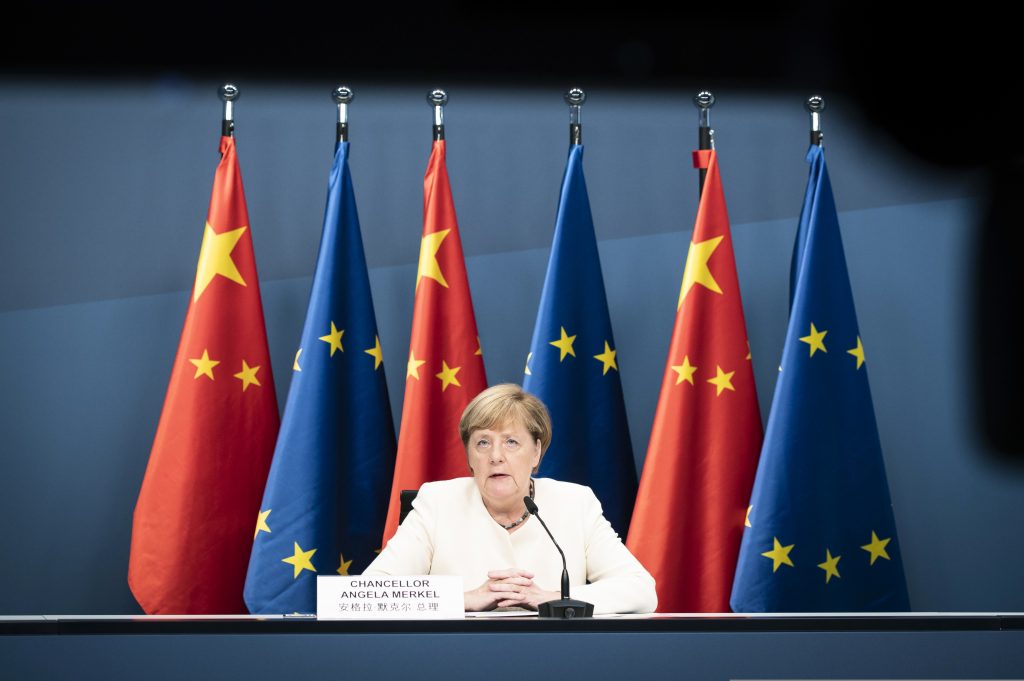
Speed is…important in developing a consolidated transatlantic strategy.
Photo Credit: Bundesregierung/Sandra Steins
A blueprint for transatlantic cooperation
This study provides the following blueprint for the Biden administration as it engages with its European and Asian partners in addressing China. It includes the following eight steps, each of which is elaborated below:
- Create a new transatlantic coordinating mechanism on China.
- Develop a common transatlantic intelligence picture of Chinese strategic intentions.
- Design common transatlantic goals for addressing China.
- Based upon those goals, construct a common transatlantic strategic approach to China which combines rivalry, competition, and cooperation.
- Design specific initiatives in areas of transatlantic convergence to counter aggressive Chinese behavior.
- Manage approaches to China in areas of transatlantic divergence and asymmetry, reducing differences wherever possible.
- Cooperate with China in areas of global common interest while verifying Chinese compliance.
- Coordinate each step with partners in Asia.
Five areas of transatlantic convergence, divergence, and asymmetry
A critical element of this blueprint is identifying areas of convergence of transatlantic interests, areas where transatlantic interests may diverge, and areas where asymmetric interests exist. By understanding areas of maximum convergence, transatlantic initiatives can be more easily developed. By identifying areas of divergence, transatlantic disputes can be avoided, and initiatives can still be designed. By understanding areas of asymmetric interest, priorities can be better understood and managed.
The areas of greatest potential transatlantic convergence, analyzed in Chapter II deal primarily with values: Chinese human rights practices, the global competition over the means of governance, China’s coercive diplomatic practices, and China’s influence operations across the globe. These issues go to the heart of what transatlantic nations stand for. In these areas, there should be ample potential and opportunity for transatlantic partners to design common approaches to protect democratic institutions and human rights. Even so, China is able to intimidate many transatlantic nations, preventing them from acting on these values alone or even speaking out. Only with a more concerted and unified transatlantic approach can sanctions or shaming have any impact on Chinese behavior.
The areas of lesser convergence, discussed in Chapter III, include China’s economic practices and its efforts to dominate new technologies and set international technology standards. Divergence among transatlantic partners here was due initially to the fact that many nations had registered immediate benefits from their economic and technological ties with China while ignoring the longer-term and less obvious risks. Divergence has appeared in the handling of the Huawei 5G issue and is also demonstrated by the fact that both the United States and the EU have negotiated trade and investment pacts separately with China. Nonetheless, China has overplayed its hand in enough instances since the onset of the COVID-19 pandemic that transatlantic partners are increasingly finding common ground on these issues as well. A place to start is countering Chinese subsidies, leverage-seeking investments, supply dependencies, cyber espionage, and similar predatory practices that give China dangerous economic, political, and technical leverage over democratic nations.
Chapter IV addresses military and security challenges where transatlantic interests are seen as asymmetric. There is general agreement on the broad challenges presented by China’s military rise, but geography in many cases creates differing priorities and responsibilities. The United States is a Pacific as well as an Atlantic power with formal commitments to defend several Asian nations and informal obligations to protect the security of others in the region. It has sufficient military capabilities to deter and challenge China, and, if necessary, defend its interests in the Indo-Pacific. With the possible exception of France, Europe has neither similar security commitments nor the military capabilities to counter China. Its security priorities are generally not in Asia. The United States’ priorities in Asia are increasing as China emerges as a major global power.
Nonetheless, the security consequences for Europe of a Sino-US military conflict are much more severe than generally appreciated. With US forces engaged in Asia, fewer available US capabilities would be dedicated to European security, European trade with China would be seriously disrupted if not completely halted, global attacks on cyber and space systems would occur, and NATO’s Article 5 on collective defense could be triggered. Europe needs to strengthen its role in deterring conflict in Asia and carry a larger military load for deterring Russia in Europe should the United States need to divert more of its forces to Asia. There is significant transatlantic convergence with respect to the impact of Chinese strategic penetration in and near Europe, but there is, thus far, limited consensus in European capitals about how to respond.
While there are recommendations throughout this study for specific policy initiatives that transatlantic nations can develop, Chapter V considers ways in which Europe and the United States can better organize themselves to manage China.
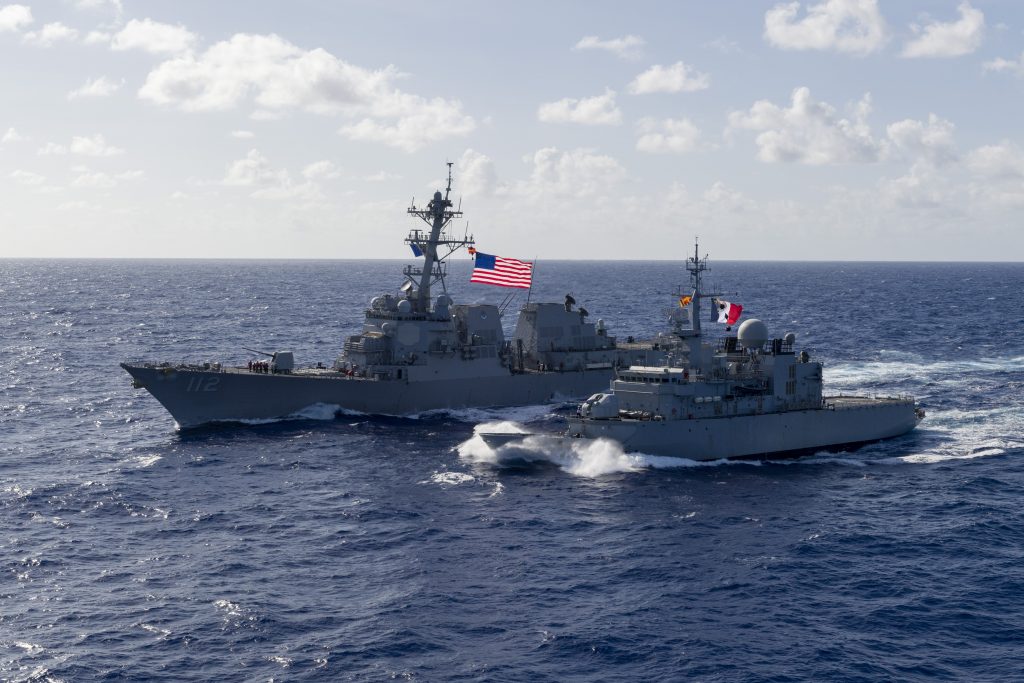
By understanding areas of maximum convergence, transatlantic initiatives can be more easily developed. By identifying areas of divergence, transatlantic disputes can be avoided, and initiatives can still be designed. By understanding areas of asymmetric interest, priorities can be better understood and managed.
The Arleigh Burke-Class guided-missile destroyer USS Michael Murphy (DDG 112) and the French frigate FNS Vendemiaire are underway in formation during a passing exercise (PASSEX) in the Pacific Ocean in January 2018. Michael Murphy was operating in the Pacific region as part of the Carl Vinson Carrier Strike Group. US Navy photo by Mass Communication Specialist 3rd Class Jasen Moreno Garcia/Released
Principal recommendations for a transatlantic approach
With this analysis of convergence, divergence, and asymmetry in the transatlantic space as a cornerstone, the following ten principal recommendations emerge as a blueprint for a coordinated transatlantic strategy toward China.
- To counter China’s divide and conquer policies, the transatlantic partners should develop an overall unified comprehensive policy toward China that combines confrontation where necessary and genuine, implemented cooperation where possible. Greater unity is needed to confront Chinese malign practices—transatlantic nations must work together to establish resilient capabilities to assure their economies, security, and values in the face of damaging Chinese activities. Policies can be designed based in large part on the degree of convergence that exists among the partners. Areas of cooperation with China may include climate change, global health, international peacekeeping, nuclear nonproliferation, and economic development; but in seeking cooperation, the transatlantic partners must not be naïve. They must insist on verifiable Chinese actions rather than idle promises that go unfulfilled.
- To organize for this effort, the partners should create a “Transatlantic Coordinating Council on China” as the central forum for discussion and coordination among relevant actors on the multiple issues that China presents. Such a forum would include the member nations of both the EU and NATO, as well as the EU and NATO as entities. The establishment of a “Transatlantic Coordinating Council on China” would allow decision making that takes into account the full scope of the issues that China presents, including when decisions in one arena have ramifications for another.
- To align transatlantic perspectives, the partners should develop a unified, comprehensive, and dynamic “common intelligence picture” of China’s strategic direction. They should establish a consortium of national-level allied and partner intelligence services to cooperate on analytic and intelligence-gathering activities on China.
- To develop common transatlantic goals, the partners should consider the following:
- minimizing transatlantic differences as nations design their policies toward China
- protecting common transatlantic interests from the impact of malign Chinese economic, technological, and diplomatic practices
- upholding democratic and human rights values
- deterring Chinese military practices that could lead to armed conflict
- convincing China’s leadership that it is in their best interest to operate in the current liberal international order
- cooperating with China where interests align in order to meet these goals
- To counter malign Chinese domestic human rights and autocratic practices, the partners should
- organize a concerted effort, including using the proposed D-10 mechanism, to promote the value of democracy, human rights, and importance of good governance;
- continue a staunch, multilateral push for independent investigation and fact-finding missions to China to investigate human rights violations, including through the EU and the United Nations Human Rights Council;
- swiftly negate all extradition treaties with China or Hong Kong under the principle of non-refoulement. No other country should enter into further extradition agreements with China; and
- enact stringent legislation limiting exports of European and US technology to China that could be used for mass surveillance purposes, establish a monitoring system to enhance transparency along supply chains and introduce in-depth assessments of human rights risks, and introduce liability legislation for companies that use supplies and suppliers where forced labor is a known risk.
- To counter coercive Chinese diplomacy, excessive intelligence gathering, and disinformation practices, the partners should
- respond collectively to any case of diplomatic bullying of one partner with a “coercion against one is coercion against all” policy;
- reengage in international organizations to limit Chinese power;
- create transatlantic rapid-response mechanisms to offset Chinese disinformation; and
- register Chinese “civil society” groups operating in the transatlantic space to limit intelligence gathering and influence peddling.
- To counter predatory Chinese economic policies, the partners should
- exclude any Chinese products and services from supply chains vital to national security;
- for non-strategic sectors unfairly affected by China’s state-directed economic practices, establish frameworks to have selective offsetting impact, including import restraints and tariffs. For other commercial products and services to commercial users, subject trade to the caveats that access to the US and European markets should depend on generally comparable access to China’s domestic market and that forced technology transfer should be barred;
- work together to ensure that there are alternatives to China’s Huawei by developing open-architecture 5G capabilities;
- create a resilience plan for all key critical infrastructure supply chains to avoid over-dependency on China, including having sufficient non-Chinese companies in critical infrastructure supply chains so that China does not have a dominant position;
- develop a coordinated transatlantic approach to establishing resilient cybersecurity architectures to be utilized by businesses as a key element in providing protection against Chinese cyber espionage; and
- work together to provide investment and technical assistance in sectors related to climate change, environment, health, and water as alternatives to Chinese sponsored action.
- To counter Chinese efforts to dominate global technology, the partners should
- systematically educate industry and government stakeholders on the risks of covert technology transfers through regular business and research and development (R&D) exchanges with Chinese entities;
- bolster R&D in strategic sectors and protect industries from unfairly subsidized competition in domestic and global markets;
- enhance US and allied presence in technology standard-setting bodies; and
- block technology transfers to China that could further fuel China’s military buildup, even indirectly.
- To counter China’s global and regional military challenges, the partners should
- enhance Europe’s military capabilities so that Europe has effective defenses should conflict in Asia divert US attention and forces;
- enhance deterrence in Asia by clarifying to China that NATO allies would not stand by should China attack US forces in Asia;
- commit through NATO to defend freedoms in the global commons;
- prevent further Chinese strategic investments in NATO countries that would stall NATO decision making or mobilization during a crisis;
- organize NATO to give it maximum capability to deal with the challenges from China; and
- form a “NATO-China Council” similar to the NATO-Russia Council to engage with China to discuss security issues.
- These unified efforts need not be packaged in one set of comprehensive demands. The general transatlantic strategy toward China should be a coordinated effort to deter Chinese malign behavior where necessary and cooperate with China where possible, making sure that cooperation is implemented. These efforts are likely more manageable if approached in bite-sized chunks, allowing consensus among democratic nations to form around them. As specific transatlantic initiatives emerge, they need to be balanced to account for national priorities.

The Scowcroft Center for Strategy and Security works to develop sustainable, nonpartisan strategies to address the most important security challenges facing the United States and the world.

The Transatlantic Security Initiative, in the Scowcroft Center for Strategy and Security, shapes and influences the debate on the greatest security challenges facing the North Atlantic Alliance and its key partners.
Further reading
Subscribe for events and publications on transatlantic security
Sign up for updates from the Atlantic Council’s Transatlantic Security Initiative, covering the debate on the greatest security challenges facing the North Atlantic Alliance and its key partners.
